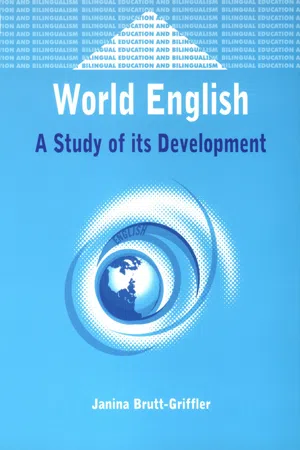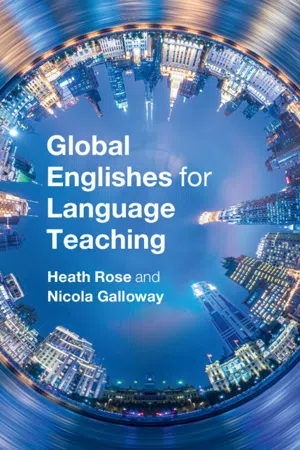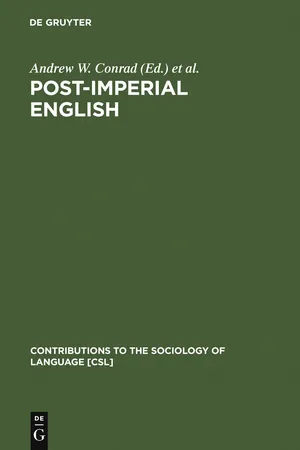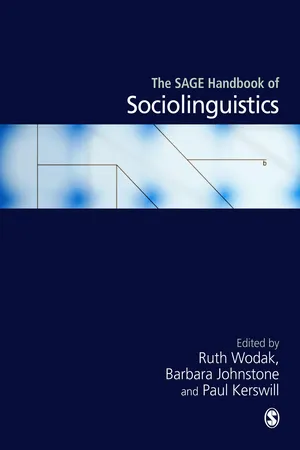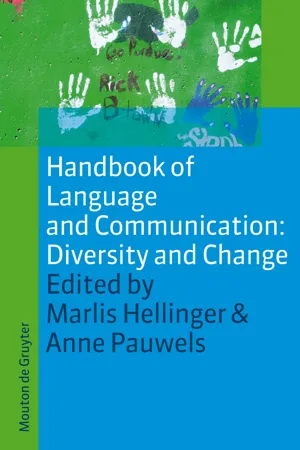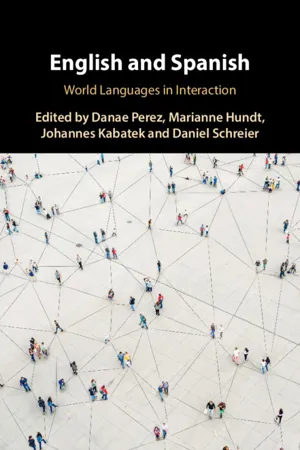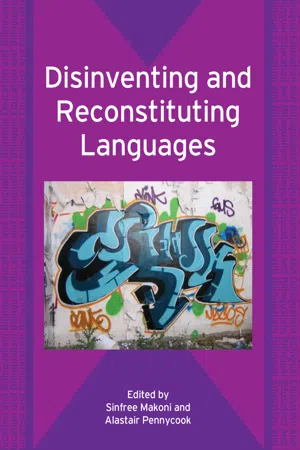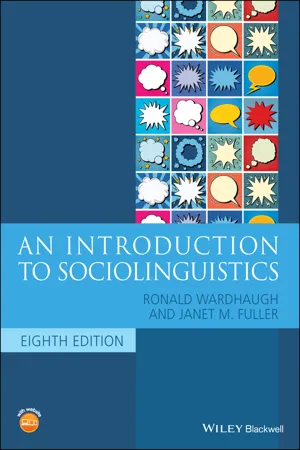Languages & Linguistics
International English
International English refers to the use of the English language as a global lingua franca, with variations in vocabulary, pronunciation, and grammar influenced by different cultures and regions. It encompasses the diverse ways English is spoken and written around the world, reflecting the language's adaptability and evolution in response to international communication and interaction.
Written by Perlego with AI-assistance
Related key terms
1 of 5
10 Key excerpts on "International English"
- eBook - PDF
World English
A Study of its Development
- Janina Brutt-Griffler(Author)
- 2002(Publication Date)
- Multilingual Matters(Publisher)
Linguistic questions in World English While this debate over the praxis and ethics of World English helped inaugurate a new scholarly discipline, linguistic issues have subsequently come increasingly to the fore. One question emerged above all: taking not a functional but a linguistic standpoint, just what sort of system, if any, does World English represent? Given that the study of World English grew out of concerns of the field of applied linguistics, it was perhaps not surprising that the attempts to represent that system should be drawn first from theories of second language acquisition (SLA). Almost a decade after his seminal paper on English as an International Language, Smith (1987) addressed what he considered to be a possible misinterpretation of the notion of EIL: Referring to professionally and technologically based limited domains of English usage, he insisted “EIL is not English for special purposes with a restricted linguistic corpus for use in international settings” (p. xi). 6 In direct contrast, in Widdowson’s (1997) understanding of World English, the international language com-prises varieties of English for specific purposes, “autonomous registers 111 011 111 0111 0111 0 1111 Images of World English 7 7 which guarantee specialist communication within global expert commu-nities” (p. 144). 7 Davies (1989), relating the question of World English to current theo-ries of SLA, posits the question: “Is International English an Inter-language?” – alluding to a dominant paradigm for explaining the second language learner’s progress. 8 He rejects the notion of defining World English as an interlanguage (IL) on the grounds that the latter properly accounts for individual language development and variation, whereas World English “deals with societal varieties” (p. 447). He argues that an IL cannot be “an international language because it is not a full language, nor is it a reduced or treated one. - eBook - PDF
- Heath Rose, Nicola Galloway(Authors)
- 2019(Publication Date)
- Cambridge University Press(Publisher)
In this book, we posit Global Englishes as an umbrella term to unite the shared endeavours of these interrelated fields of study in sociolinguistics and applied linguistics. We use it to consolidate research in World Englishes, English as a lingua franca and English as an international language, while drawing on scholarship from translanguaging and multilingualism in second language acquisition. Thus, we define Global Englishes as an inclusive paradigm that embraces a broad spectrum of inter- related research that has come before it and emerged alongside it. Thus, to fully understand Global Englishes, one needs to examine more closely the inter- related fields of World Englishes, English as a lingua franca, English as an international language and translanguaging. World Englishes World Englishes as a discipline began as both a linguistic and a sociolinguistic school of study in the 1970s and 1980s, largely informed by the theoretical work of Braj J. Kachru and Larry Smith. It was primarily concerned with recording and codifying linguistic variation in English, with special interest in the Englishes of former British colonies. The oft-cited model of World Englishes is Kachru’ s (1992) groundbreaking Three Circle model, consisting of the Inner Circle, Outer Circle and Expanding Circle. The Inner Circle includes countries where English serves as a first language and spread to the country as a direct result of English-speaking colonisation and migration. Illustrative Inner Circle countries include the United Kingdom, Ireland, Australia, New Zealand, Canada and the United States. Although it is an additional language for many speakers in these countries from other linguistic backgrounds, the predominant official language is English. The Outer Circle includes countries of the former British Empire where English operates pre- dominantly as a second language alongside other national languages (although 6 Introducing Global Englishes for Language Teaching - eBook - PDF
- Prof. Nancy H. Hornberger, Dr. Sandra Lee McKay, Nancy H. Hornberger, Sandra Lee McKay(Authors)
- 2010(Publication Date)
- Multilingual Matters(Publisher)
Those at the base of the English as an International Language 91 triangle have lower levels of proficiency, typically have lower levels of education, and tend to come from a lower socio-economic background. They are more restricted in their movement along the formality cline, and can usually speak only the colloquial forms of Singapore English. What World Englishes interpretations attempt to do is to develop a model that describes and legitimizes a pluricentric view of English, and one that moves away from a view of there being just one standard form against which all others are measured. As argued by Kachru (1983, 1992), English has ‘blended itself with the cultural and social complex’ (1983: 139) of the country and has thereby become ‘culture-bound’ (1983: 140) in it. Therefore, he argues, new Englishes cannot be characterized in terms of acquisitional inadequacy, or be judged by the norms of English in Inner Circle countries. The World Englishes paradigm attempts to place all vari-eties of English on par with each other without any one being a reference point. Although the paradigm has made a significant contribution to our understanding of International English in its recognition of the pluricen-tric nature of current English use, what it fails to do is to recognize the localized nature of English language use in which bilingual/multilingual individuals draw on their full linguistic repertoire to signal their local and global identity. English as a Lingua Franca Recently, a good deal of attention has been focused on an analysis of interactions between L2 speakers of English, termed English as a Lingua Franca (ELF) talk. - eBook - PDF
Post-Imperial English
Status Change in Former British and American Colonies, 1940-1990
- Andrew W. Conrad, Alma Rubal-Lopez, Andrew W. Conrad, Alma Rubal-Lopez(Authors)
- 2011(Publication Date)
- De Gruyter Mouton(Publisher)
The viewpoints range from those which view the univer-sally acknowledged importance of English with great alarm to those which view it positively, as a potential means for growing world unity and The international role of English 15 peace. I will look for those areas of communication between opposing viewpoints as well as explanations for the directions studies have pursued in the nature of the many disciplines represented in the research un-derway as well as in the terms in which researchers cast their questions and findings. My purpose is less to defend any approach than it is to clarify the issues we need to understand in order to proceed. Several important collections of papers on the subject of English around the world have appeared during the past decade and a half. John Pride edited New Englishes, published by Newbury House in 1982. That volume of 15 papers raises some foundational questions (as in Moag's important paper on English as a foreign, second, native, and basal lan-guage: a new taxonomy of English-using societies [1982]) while empha-sizing emerging varieties of English and some of the problems that such development involves. Jenny Cheshire's English around the world (1991) emphasizes descriptive analyses of the differences among major varieties of English. Wolfgang Viereck and Wolf-Dietrich Bald edited English in contact with other languages, a substantial collection of papers discussing complex contact situations involving both domain-specific issues (like sci-entific publishing) and geographic contact. Larry E. Smith's (1983) book, Readings in English as an international language, brings together sixteen essays, including Braj Kachru's Models of non-native Englishes, to bol-ster his interest in issues of mutual intelligibility among varieties of Eng-lish, standards for written English, and auxiliary language features. - eBook - PDF
- Ruth Wodak, Barbara Johnstone, Paul E Kerswill, Ruth Wodak, Barbara Johnstone, Paul E Kerswill(Authors)
- 2010(Publication Date)
- SAGE Publications Ltd(Publisher)
English is now embedded in many parts of the global system: one need only map it against a list of ‘scapes’ (finance, media, tourist, religion, knowledge production) to see its global significance. At the very least, we need to understand how English operates in an uneven world (cf. Radhakrishnan, 2003), how English is involved in global flows of culture and knowl-edge, and how English is used and appropriated by users of English round the world, from popular culture to unpopular politics, from international capital to local transaction, from diplomacy to peacekeeping, from religious proselytizing to secular resistance. Yet the very conditions of globalization and the role of global English also demand that we rethink what we mean by language, language spread, native speakers, or multilingualism. Indeed, globalization requires us to consider whether we should continue to think of languages as separate, distinguishable, countable entities. I shall return to these concerns at the end of this chapter after looking in greater depth at the social, cultural and political roles played by English, and the changes that English has undergone. 34.3 ENGLISH IN AN UNEVEN WORLD The first set of concerns about English and glo-balization are questions of the sociology of English and its relation to globalization. It is common in language studies and English language teaching to talk in terms of English as the ‘language of inter-national communication’ rather than a language embedded in processes of globalization. English is all too often assumed to be a language that holds out the promise of social and economic development to all those who learn it, a language of equal opportunity, a language that the world needs in order to be able to communicate. - Marlis Hellinger, Anne Pauwels, Marlis Hellinger, Anne Pauwels(Authors)
- 2008(Publication Date)
- De Gruyter Mouton(Publisher)
The monolingual speaker of English is almost certainly a native speaker of it and is a member of a dwindling minority. The tension between these scholars lies in their different approaches. Bolton (2003: 42–43) has identified no fewer than twelve different approaches to the study of World Englishes ranging from “English Studies” through “Kachruvian Studies” to “Futurology”. In a later paper (2005) he helpfully reduces these to three basic approaches. These are: Linguistic (e.g., English studies and corpus linguistics) Linguistic and sociopolitical (e.g., sociolinguistics and World Englishes) Sociopolitical and political (e.g., Linguistic Imperialism). It is not difficult to see why there are tensions here. By definition, applied lin-guistics is primarily about language not politics, although applied linguists must work across disciplines as they research language variation and change, how language is used in a variety of settings and domains, and how those settings and domains shape the language being used. Applied linguists conduct contextual-ised studies based on linguistic data where, for example, the relationship be-tween a language of wider communication with a local language can be system-atically analysed, taking into account specific and changing circumstances (Conrad 1996). Thus a criticism of Linguistic Imperialism is that it is too ab-stract, impersonal and global. It ignores “the individual, the local, the particu-lar” (Canagarajah 1995: 592). This response is echoed by Fishman and provided the impetus for the studies in Fishman, Conrad, and Rubal-Lopez (1996). In Fishman’s words: Linguistic imperialism? English as a global language 347 What we need now […] is to set aside worldwide catch-all theories for a while […] and to look for regional differences or clusters of countries […] where the status change processes vis à vis English have turned out one way, and others in which they may have turned out another way (or ways).- eBook - PDF
- Mario Saraceni(Author)
- 2015(Publication Date)
- Bloomsbury Academic(Publisher)
WORLD ENGLISHES: A CRITICAL ANALYSIS 74 In the same period, Kachru’s colleague Larry Smith expressed very similar views: It is important to note that there is a single English language but many varieties. The language of the United States is American English. Certainly speakers of American English are identifiable by their pronunciation, intonation, stress, rhythm, and some vocabulary items but the language (the general orthography, lexicology, semantics, syntax – the grammar, if you will), is English. It is the same English that is spoken in Singapore, however; Singapore English speakers are also identifiable by their pronunciation, intonation, stress, rhythm, and some vocabulary items. (L. E. Smith, 1976, p. 38) Again, these were soon to become central points in the World Englishes, where one of the central ideas is that specific linguistic features characterize distinctive varieties of English which, in turn, are associated to their respective countries. There was, therefore, a clear debate between those who held conservative views about English and tended to regard the existence of too many varieties of the language as disadvantageous and those persuaded that plurality was a defining characteristic of English in the world. It was, as Bolton (2004, p. 368) observes, ‘an evident concern with monocentrism versus pluricentrism, i.e. one English (with all its geographical and social varieties), or multifarious Englishes (deserving consideration and recognition as autonomous or semi-autonomous varieties of the language)’. It was a debate destined to continue through time. Meanwhile, pluricentrism began to gain momentum in the early 1980s, as important book-length publications appeared. - eBook - PDF
English and Spanish
World Languages in Interaction
- Danae Perez, Marianne Hundt, Johannes Kabatek, Daniel Schreier(Authors)
- 2021(Publication Date)
- Cambridge University Press(Publisher)
With global travel and other kinds of interrelationships expanding rapidly, these varieties have become increasingly visible on an international level. The growth of these new varieties thus both reflects and also pushes the internation- ally strong role of English. New Englishes are products of and contribute to the local or regional re-rooting of English; they strengthen the international stand- ing and visibility of the language and our global awareness for the diversity and variability of English. The mutual influence of new varieties on each other is also increasing. For instance, with business and other contacts growing continuously, branches of universities being set up in other countries, and similar developments, the Englishes of Australia and (less so) New Zealand increasingly come to be seen as linguistic role models in countries around the Pacific Rim and in Asia, challenging the traditional norm-providing role of British or American English. Hundt (2013) discusses the question of how the status of such new varieties as potential ‘epicenters’ can be empirically verified. This development has been recognized by Crystal (2009) as well, who associates the growing impact of New Englishes on global English with increasing power and prestige (173): “these days, regional national varieties of English are increasingly being used with prestige on the international scene” (174). One necessary consequence, obviously, is the need to recognize increas- ing multidialectalism within a newly conceptualized notion of English. The language cannot be regarded as a monolithic ‘standard’ entity any longer. Instead, it makes much more sense to think of an “English family of lan- guages” (177) or a range of variety types (including some strongly contact- induced ones which are quite different from metropolitan ‘standard English’), labeled the “English Language Complex” by Mesthrie and Bhatt (2008: 1–8). The Emergence of Global Languages 19 - eBook - PDF
- Sinfree Makoni, Alastair Pennycook, Sinfree Makoni, Alastair Pennycook, Sinfree Bullock Makoni(Authors)
- 2006(Publication Date)
- Multilingual Matters(Publisher)
For a world English to be such, it must adhere to the underlying grammar of central English, demonstrate enough variety to make it inter-estingly different, but not diverge to the extent that it undermines the myth of English. If we acknowledge creole languages, however, if we refuse to draw a line down the middle of a creole continuum (exclaiming that one end is English while the other is not), if we decide that those ‘Other Englishes’ may be part of English, then we are not dealing with a language held in place by a core structure but rather a notion of language status that is not definable by interior criteria. Conclusion: Language Effects and Mobilisations Returning to and rewriting Barthes for a moment, we can suggest that the myth (or myths) of English as an international language (EIL) can be understood as making the local contingencies of English appear to have broader ontological and temporal validity and a natural justification. The myth(s) of EIL erase the memory that English is a fabrication, that languages are inventions and that talk of English as an international language is a piece of intellectual slippage that replaces the history of this invention with a belief in its natural identity. The myth of EIL depoliticises English, and does so not by ignoring English but by constantly talking about it, making English innocent, giving it a natural and eternal justifica-tion, a clarity that is not that of a description but an assumption of fact. The myth of EIL deals not merely with the invention of English, but with the strategies that constantly keep that invention in place, with the relentless repetition of the stories and tales about this thing called English. We need to disinvent English, to demythologise it, and then to look at how a reinvention of English may help us understand more clearly what it is we are dealing with here. - eBook - PDF
- Ronald Wardhaugh, Janet M. Fuller(Authors)
- 2021(Publication Date)
- Wiley-Blackwell(Publisher)
Languages, Communities, and Contexts Part I An Introduction to Sociolinguistics, Eighth Edition. Ronald Wardhaugh and Janet M. Fuller. © 2021 John Wiley & Sons Ltd. Published 2021 by John Wiley & Sons Ltd. Companion website: www.wiley.com/go/wardhaugh8e 2 We stated in the introductory chapter that the concept of language is considered by many sociolinguists to be an ideological construct. Further, we noted that all languages exhibit internal variation, that is, each language exists in a number of varieties and is in one sense the sum of those varieties. We use the term variety as a general term for a way of speaking; this may be something as broad as Standard English, or a variety defined in terms of loca- tion and social class (e.g., ‘working-class New York City speech’), or something defined by its function or where it is used, such as ‘legalese.’ In the following sections, we will explore these different ways of specifying language varieties and how we define the terms ‘lan- guage’ and ‘dialect’ (regional and social). We will also address how the associations between language and social meaning develop and are used in communicating in different speech contexts. What is a Language? What do we mean when we refer to a language or, even more important, the idea of mixing languages? As we will discuss further in chapters 8 and 9, recent research has coined many new terms to describe what has traditionally been called multilingualism – ‘(trans)lan- guaging,’ ‘metrolingualism,’ ‘heteroglossia.’ These terms reflect the idea that languages are ideological constructs; while we (usually) have names for different ways of speaking and can describe their features, in practice linguistic boundaries may be fluid.
Index pages curate the most relevant extracts from our library of academic textbooks. They’ve been created using an in-house natural language model (NLM), each adding context and meaning to key research topics.
